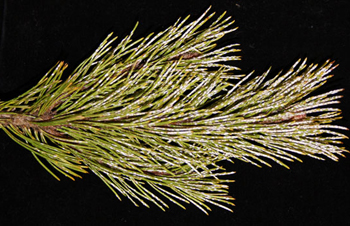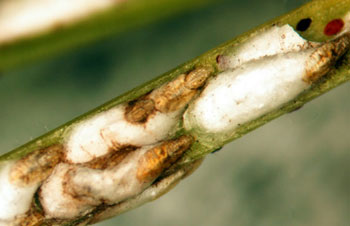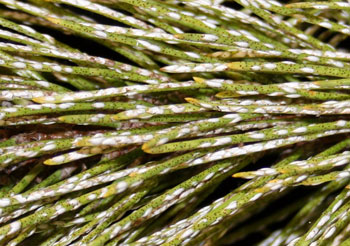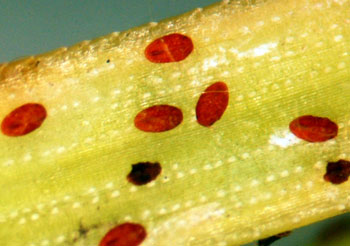First generation pine needle scale crawlers should be hatching
First generation of pine needle scale hatch and the tiny crawlers emerge when lilac blooms in the spring.
Pine needle scale, Chionaspis pinifolia (Hemiptera: Diaspididae), can be a serious pest of Christmas trees and ornamental pines that can cause branch dieback and tree mortality with heavy infestations. Pine needle scale is more likely to be a problem on imported species of two-needle pines such as Scotch and Mugo, but large numbers have been occasionally reported on red pine, spruce and Fraser fir.
Pine needle scale feeds by sucking plant juices from the needles, causing them to turn yellow and eventually brown. As pine needle scale numbers build, the needles become covered with the tiny, white scale insects.


(Left) A mugo pine branch that is heavily infested with pine needle scale. (Right) A close-up of the
pine needle scale. Photo credits: Howard Russell, MSU Diagnostic Services
There are two generations of pine needle scale in Michigan. First generation eggs hatch and the tiny crawlers emerge when lilacs begin to bloom in the spring. As with other armored scales, pine needle scale overwinters in the egg stage under the dead female scales and, therefore, dormant oils are not effective against pine needle scale. Neonictoniod insecticides injected or applied as a soil drench are generally not effective against pine needle scale and other armored scales. Effective control can only be achieved with insecticide sprays aimed at the crawler stage.
For those who track and utilize growing degree day (GDD) accumulations for timing applications, the first generation of eggs usually hatch around 250 to 400 GDD base 50. It's not necessary to apply an insecticide immediately after you see the reddish-colored crawlers. In fact, it's best to let the crawlers settle down and establish feeding sites on the needles (the hyaline stage – 400 to 500 GDD base 50). At this point, the immature scales are exposed and have not yet secreted the white, waxy protective armor. If you can apply your spray at this point and if you get good coverage, Michigan State University Extension says you should get good control. The second generation crawlers appear in late July and offer another opportunity to control the scale.


(Left) Pine needle scale crawler emergence on a heavily infected pine. The little dark spots are the
crawlers. (Right) A close-up of pine needle scale crawlers. Photo credits: Howard Russell, MSU Diagnostic Services
Good scouting will help you assess the size of the pine needle scale population in your field. Scouting is important to determine whether control is necessary and the best timing for control.
If you see lots of scales with a round hole or a hole with jagged edges, it is evidence that parasitoids (round holes) and predators (jagged holes) have attacked the scales. Also, check to see if there are viable eggs below the hard white scale armor. Carefully flip off the white armor and see if you see the little reddish eggs. If you don’t find eggs under most scales, then you may not need to worry about spraying. Inspect susceptible species of pine at least twice a year for yellowing and large numbers of scales. If pine needle scale becomes numerous and the tree shows signs of stress, then control measures should be considered.

Pine needle scale damage. Photo credit: Jill O’Donnell, MSU Extension
The least disruptive method is to apply summer horticultural oil sprays when the crawlers are active during the bloom period of common lilac. Summer oils should be applied at a concentration of 1 to 1.5 percent. A more aggressive strategy is to apply a spray containing a broad spectrum insecticide containing acephate, bifenthrin, carbaryl, chlorpyrifos or cyfluthrin when the first generation crawlers are hatching. It is important to provide full coverage of the insecticide to interior portions of the tree, particularly lower branches. Be sure to read and follow all the instructions and safety precautions found on the pesticide label before using any pesticide.



 Print
Print Email
Email




